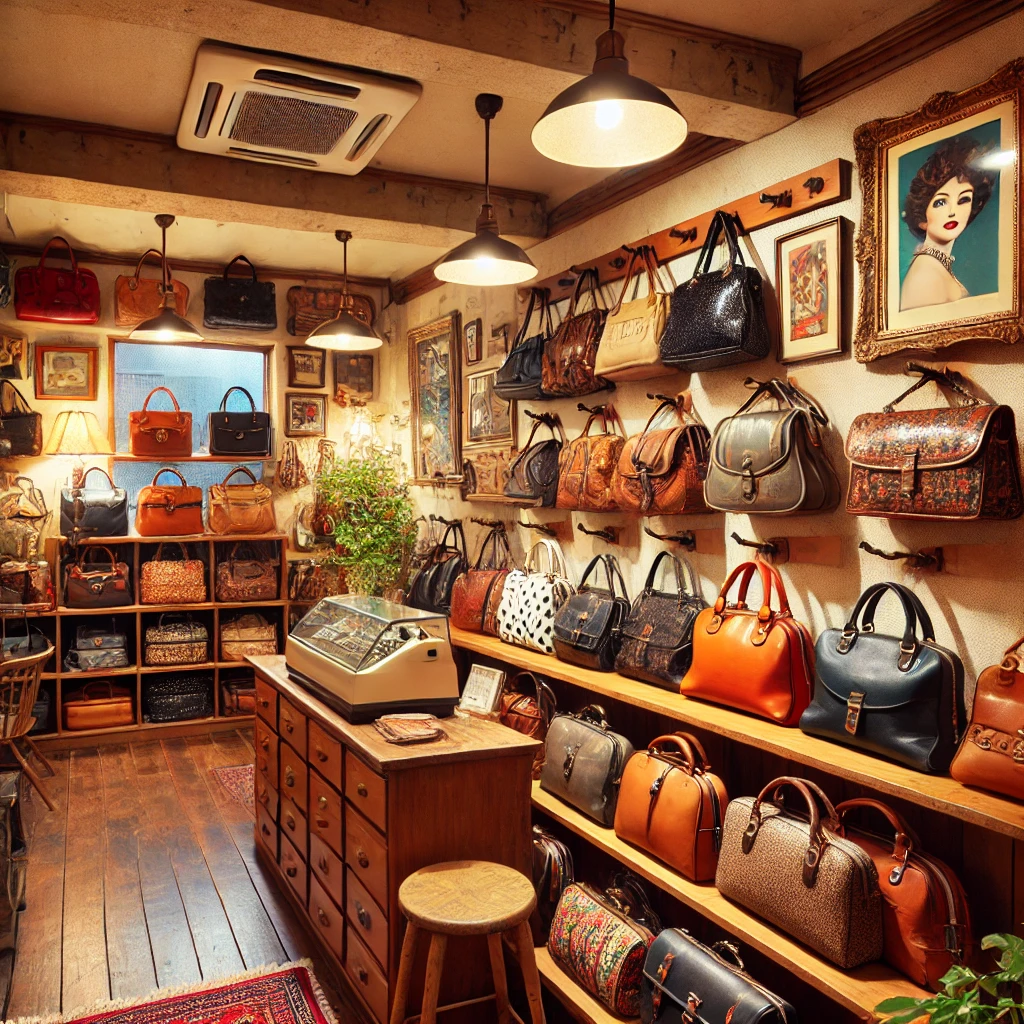**Disclosure:** We believe in honesty and transparency to the fullest extent. Some of the links on this blog are affiliate links, meaning, at no additional cost to you, we will earn a commission if you click through and make a purchase. This is one of the simplest ways you can support us.

The resale revolution is here, and thrift stores are thriving like never before. With more consumers seeking budget-friendly options and a growing demand for sustainable fashion, the second-hand market has seen explosive growth in recent years. From vintage clothing to furniture and even luxury items, shoppers are looking for unique finds while being more conscious about their environmental footprint.
While opening a thrift store can be a lucrative business venture, simply opening the doors and selling second-hand goods won’t guarantee success. The key to standing out in today’s competitive thrift market is finding a unique niche—one that draws in a specific audience and keeps them coming back. This article will guide you through the steps of starting a profitable thrift store and emphasize why honing in on a niche is critical for your long-term success.
Benefits of Starting a Thrift Store
Starting a thrift store comes with a variety of benefits that make it an appealing option for aspiring entrepreneurs. Here are a few reasons why thrift stores can be profitable and impactful:
- Low Startup Costs: One of the most attractive aspects of opening a thrift store is the relatively low cost of entry. Inventory is often sourced through donations, estate sales, or liquidation, allowing for minimal upfront investment. This low-cost inventory model reduces financial risk while maximizing profit margins.
- Sustainability Appeal: As consumers become more eco-conscious, sustainability is becoming a key consideration in purchasing decisions. Thrift stores offer a greener alternative to fast fashion and disposable consumerism by promoting the reuse and recycling of items. This gives your business an ethical edge that appeals to environmentally-minded shoppers.
- High Demand for Affordable Fashion: In an era where the cost of living is rising, shoppers are increasingly turning to thrift stores for affordable alternatives to new clothing and goods. Thrift stores are particularly popular among younger generations, such as Gen Z and Millennials, who prioritize both style and savings.
Overall, starting a thrift store provides a unique opportunity to tap into the growing demand for affordable, sustainable shopping options. However, to truly thrive in this market, it’s essential to carve out a distinct niche that sets your store apart from the competition.

Importance of Finding Your Niche
Finding a niche is one of the most critical aspects of starting a profitable thrift store. A niche allows you to specialize in a specific category of products or appeal to a particular audience, setting you apart from the competition and helping you attract a loyal customer base. In a saturated market, having a niche will make your thrift store memorable and allow you to build a brand that resonates with your target customers.
Why a Niche Matters:
- Differentiation: With thrift stores becoming more popular, it’s essential to stand out. A niche helps you focus on a specific market segment, making your store unique and more appealing to a defined group of customers.
- Targeted Marketing: When you have a clear niche, your marketing efforts can be more targeted and effective. Instead of trying to appeal to everyone, you can focus on a group that is specifically interested in what you offer, resulting in more efficient marketing and higher customer retention.
- Curated Inventory: A niche allows you to curate your inventory to meet the tastes and needs of your audience. This means that customers will know exactly what to expect when they visit your store, making them more likely to return. It also makes sourcing products easier, as you can focus on acquiring items that fit your specialty.
Common Thrift Store Niches:
- Vintage Clothing: Specializing in retro or vintage fashion from specific eras (e.g., 80s, 90s) appeals to fashion-forward customers looking for unique and nostalgic styles.
- Luxury Resale: Focusing on high-end or designer goods provides a market for customers seeking affordable luxury. A thrift store specializing in authentic second-hand designer items can command higher prices and attract a more affluent clientele.
- Kids & Baby Items: Targeting families by offering gently used baby gear, toys, and kids’ clothes can be highly profitable, as parents are always looking for affordable alternatives to buying new.
- Furniture & Home Décor: Some thrift stores focus exclusively on second-hand furniture and home décor items, catering to customers who enjoy DIY projects or want to decorate their homes with unique pieces.
- Eco-Friendly Fashion: A thrift store specializing in sustainable or upcycled fashion caters to eco-conscious shoppers who prioritize reducing waste and supporting ethical consumption.
By choosing a niche, you can create a store that is not only profitable but also memorable. Customers will know exactly what to expect from your store, making it easier to establish a loyal, repeat customer base.
Steps to Start a Profitable Thrift Store
Once you’ve chosen your niche, it’s time to start laying the groundwork for your thrift store. Follow these steps to create a successful and profitable business:
Step 1: Conduct Market Research
Before launching your thrift store, it’s essential to research your local market. Look at other thrift stores in your area to understand the competition. What types of products are they selling? Is there an underserved niche you can tap into? Understanding what your potential customers want—and what’s currently missing in the market—will help you find your store’s niche and position it for success.
- Identify Gaps in the Market: For example, if your area has plenty of general thrift stores but lacks a store focusing on vintage clothing, this could be your niche.
- Understand Customer Needs: Survey potential customers to see what types of second-hand products they are most interested in and what would draw them to your store.
Step 2: Develop a Business Plan
A well-thought-out business plan is critical to your success. This document should outline your business model, niche, target customers, and financial projections. A solid business plan will guide you through the startup process and help secure financing if needed.
- Define Your Niche and Target Market: Clearly describe the specific niche you’re focusing on and the customer segment you’ll serve.
- Financial Planning: Include startup costs such as rent, utilities, initial inventory, and marketing expenses. Estimate monthly expenses and expected revenue to understand your path to profitability.
Step 3: Secure Inventory
Sourcing quality inventory is key to running a successful thrift store. You can explore various ways to acquire inventory, including:
- Donations: Encourage local donations by setting up donation bins, hosting donation drives, or partnering with local organizations.
- Estate Sales and Auctions: These are great places to find bulk items, especially vintage furniture or clothing, often at lower costs.
- Consignment: Partner with individuals who wish to sell their items through your store, allowing you to acquire inventory without upfront costs.
Step 4: Choose a Location
Location is crucial for the success of your thrift store. Choose a spot that has high foot traffic, such as in a shopping district or near popular attractions. Additionally, make sure your location aligns with your niche. For example, a thrift store specializing in designer resale may perform better in a more affluent neighborhood, while a kids’ clothing thrift store might thrive in a family-centric community.
By carefully researching, planning, and sourcing inventory, you’ll set your thrift store up for long-term profitability and success.
Marketing Your Thrift Store
Once your thrift store is set up, effective marketing is key to attracting customers and building a loyal following. Marketing strategies should reflect your niche and target demographic, ensuring that your efforts reach the right audience. Here’s how you can promote your thrift store for maximum visibility and engagement.
Target Your Niche Audience
Understanding your niche helps you create focused marketing campaigns that appeal to your specific customer base. Whether you specialize in vintage clothing, luxury resale, or eco-friendly fashion, you’ll want to tailor your message to those most interested in what you offer.
- Social Media: Platforms like Instagram, TikTok, and Pinterest are ideal for showcasing your store’s unique finds. Regularly post pictures and videos of new inventory, styling tips, or before-and-after transformations of furniture or clothing. For a vintage niche, create posts that highlight the history or story behind certain pieces, engaging your audience with interesting facts.
- Niche-Specific Hashtags: Use relevant hashtags (e.g., #VintageFashion, #LuxuryResale, #SustainableStyle) to ensure your content reaches those searching for similar items. This can increase your store’s visibility and help attract your ideal customers.
- Email Marketing: Build an email list by offering discounts or early access to new arrivals in exchange for sign-ups. Send out weekly or monthly newsletters featuring your latest products, upcoming sales, or special events. Personalize the content based on customer preferences, such as vintage lovers receiving updates on retro styles or eco-conscious shoppers getting news on sustainable items.
Online Presence
While your brick-and-mortar store is important, expanding your online presence can significantly boost your reach and sales.
- Website and Online Store: Set up an easy-to-navigate website that allows customers to browse and purchase items from the comfort of their home. This is particularly useful for niche markets like luxury resale or vintage clothing, where customers may want to shop from other cities or even countries.
- Google My Business: Create a Google My Business profile to increase your visibility in local search results. This is crucial for driving foot traffic to your physical store, as it allows potential customers to easily find your location, hours, and contact information.
Collaborations and Events
- Pop-Up Shops: Partner with local businesses or cafes to host pop-up events. This can help you reach new customers who may not have visited your store otherwise. For example, a vintage thrift store could partner with a trendy coffee shop to host a one-day event, cross-promoting each other’s businesses.
- Influencer Collaborations: Consider working with local influencers or bloggers in your niche who can help promote your store. They can post about your products, share styling tips, or even host live shopping events on social media.
- Community Events: Hosting in-store events, like thrift fashion shows, styling workshops, or DIY upcycling tutorials, can engage the local community and encourage customer loyalty.
Managing Finances for Profitability
A successful thrift store isn’t just about offering great products—it’s also about managing your finances efficiently to ensure long-term profitability. Here are key financial considerations to keep your thrift store on track.
Pricing Strategy
Setting the right prices for your inventory is crucial to maintaining a balance between profitability and customer appeal. Since thrift store inventory is often sourced at low costs, your pricing should reflect the perceived value of the items while still offering a good deal to shoppers.
- Value-Based Pricing: For niche products like vintage or luxury items, you can command higher prices based on rarity, condition, and brand reputation. Ensure that these items are priced fairly but competitively compared to other stores or online resale platforms.
- Discounts and Sales: Offer regular discounts or clearance sales to move slower-selling inventory. Consider tiered pricing strategies, where items gradually decrease in price the longer they’ve been on the floor. This encourages frequent visits from customers looking for deals and helps keep your inventory fresh.
Monitor Inventory Turnover
Keeping track of which items sell the fastest—and which don’t—will help you refine your product offerings. Regularly reviewing your inventory turnover ensures that you’re stocking the most in-demand products for your niche.
- Fast-Selling Items: Identify your best-selling categories and focus on sourcing similar products to meet demand.
- Slow-Moving Stock: Implement markdowns or promotional events to move inventory that hasn’t sold quickly, freeing up space for new arrivals and keeping your store dynamic.
By implementing a solid pricing strategy, keeping costs low, and managing inventory turnover, you can ensure your thrift store remains profitable while attracting a steady stream of customers.
Expanding and Growing Your Thrift Store
Once your thrift store is established and generating consistent profits, you may start thinking about expansion. Growing your business can take many forms, from opening additional locations to diversifying your product offerings. Here are key strategies to expand and scale your thrift store successfully:
Diversify Inventory
As your thrift store grows, consider expanding your inventory to include complementary product lines or seasonal collections. This can help you attract a wider range of customers while maintaining your niche focus.
- Seasonal Items: Offer seasonal collections such as winter coats, summer dresses, or holiday décor to keep customers coming back throughout the year.
- Curated Collections: If your niche is vintage clothing, create special themed collections based on specific decades or fashion trends. This keeps your inventory fresh and exciting for returning customers.
- Upcycled or Repurposed Items: Partner with local artists or craftsmen to offer upcycled furniture, clothing, or accessories. This can appeal to eco-conscious shoppers and adds unique, one-of-a-kind items to your inventory.
E-Commerce Expansion
Consider expanding your online presence by building a robust e-commerce platform. This allows you to reach a larger audience, especially if your niche items (like vintage or luxury goods) have nationwide or international appeal.
- Shipping and Fulfillment: If you start selling online, ensure you have a reliable shipping and fulfillment process in place. Offer clear shipping rates, processing times, and customer service to ensure a smooth experience.
- Digital Marketing: Use targeted online ads, SEO, and social media marketing to drive traffic to your website and increase online sales. Building a strong digital presence can complement your physical store and grow your customer base exponentially.
Building a Brand
In a competitive market, branding is crucial to differentiate your thrift store and create a lasting impression. Your brand should reflect your niche, mission, and values, helping you connect with your target audience on a deeper level. Here’s how to build a strong, memorable brand:
Create a Unique Identity
Your store’s brand identity goes beyond just the products you sell. It’s about creating an experience for your customers that keeps them coming back. Your branding should be consistent across all touchpoints, from your physical store to your website and social media channels.
- Logo and Visuals: Develop a strong, recognizable logo and visual style that reflects your niche. For example, a thrift store specializing in eco-friendly fashion might use earthy colors and a minimalist logo to convey sustainability.
- Store Design: The design and layout of your store should align with your brand identity. A luxury resale store should have an upscale, clean layout with stylish décor, while a vintage store might feature retro furniture and vibrant displays that reflect the items being sold.
- Tone and Messaging: Your store’s voice and tone should be consistent across all marketing channels. Whether it’s playful and fun for a kids’ thrift store or chic and sophisticated for a luxury resale shop, the tone should resonate with your target customers.
Mission and Values
Communicate your store’s mission and values clearly. Many successful thrift stores tap into the growing consumer demand for sustainability, ethical consumption, and community impact. Emphasizing your store’s role in reducing waste and promoting eco-conscious shopping can resonate deeply with customers, especially if your niche focuses on sustainable fashion or upcycled goods.
- Community Engagement: Build your brand by getting involved with your local community. Host charity drives, sponsor local events, or offer workshops (e.g., DIY upcycling or styling tips). Engaging with the community builds customer loyalty and enhances your store’s reputation.
- Storytelling: Use storytelling to connect with your customers. Share the story behind your thrift store’s origin, the unique items you carry, or the impact you’re making through eco-friendly practices. Customers love supporting businesses that align with their values and have a compelling story.
Building Customer Loyalty
Loyalty programs, personalized marketing, and excellent customer service are key to building lasting relationships with your customers.
- Loyalty Programs: Offer a loyalty program where customers earn points or discounts with each purchase. This encourages repeat visits and builds a loyal customer base.
- Personalized Communication: Use your email list and social media to engage with customers directly. Send personalized recommendations based on their past purchases or offer exclusive early access to new inventory for loyal shoppers.
- Exceptional Customer Service: Train your staff to provide top-notch customer service. A positive shopping experience—whether in-store or online—will keep customers coming back and leave a lasting impression.
The Importance of Inventory Management
Managing your inventory effectively is critical for the profitability and smooth operation of your thrift store. Unlike traditional retail stores, thrift store inventory is often sourced from various locations, including donations, estate sales, and consignments, which can make tracking and organization more complex. Here’s how to manage your inventory efficiently to keep your store well-stocked and appealing to customers.
Tracking Inventory
Keeping track of what’s coming in and what’s going out is essential, especially in a thrift store where items are often one-of-a-kind. By monitoring your inventory closely, you can ensure that your best-selling items are always in stock and reduce the chance of having stagnant, unsellable products taking up space.
- Point of Sale (POS) Systems: Invest in a reliable POS system that allows you to track sales and inventory in real time. This can help you analyze which items are popular and which categories may need restocking. Some systems are designed specifically for resale and thrift stores, providing features like consignment management and donation tracking.
- Inventory Categorization: Organize your inventory by category, such as clothing, furniture, or home décor. You can also break it down further by size, season, or style to ensure easy access for staff and a smooth shopping experience for customers.
Inventory Rotation
Rotating inventory regularly keeps your store fresh and encourages repeat visits. If customers know that new items are added frequently, they’ll be more likely to stop by often to see what’s new.
- New Arrivals Section: Dedicate a section of your store to new arrivals. Rotating stock into this section makes it easier for customers to spot fresh merchandise, creating excitement and urgency to buy.
- Clearance Section: Move slow-moving items to a clearance section and offer discounts to clear them out. This will free up space for new, in-demand items and prevent your store from becoming cluttered with unsellable inventory.
Sourcing High-Quality Items
Ensuring that you consistently have high-quality items is crucial to maintaining your store’s reputation. This is especially important for niche stores like vintage clothing or luxury resale, where customers expect well-preserved and authentic products.
- Donation Drives: Host regular donation drives to source new inventory. Collaborate with local businesses or community organizations to collect quality items, offering incentives like store discounts in exchange for donations.
- Consignment Agreements: Establish consignment partnerships where individuals bring in items to sell, and you take a percentage of the profit. This is a low-risk way to keep your inventory stocked with high-quality goods without needing to invest upfront.
Customer Experience: Creating a Memorable Shopping Environment
The experience you create for your customers plays a vital role in the success of your thrift store. A positive shopping environment, both in-store and online, can turn first-time visitors into loyal customers who return again and again. Here’s how to ensure that your customer experience is top-notch.
Store Layout and Design
Your store layout should reflect your niche and make it easy for customers to browse and find what they’re looking for. A clean, well-organized store encourages customers to spend more time shopping and increases the likelihood of making a purchase.
- Organized and Accessible Displays: Ensure that your products are neatly arranged and easy to browse. Group similar items together by category or theme to make the shopping experience seamless. For example, if you specialize in vintage clothing, separate items by decade or style.
- Visual Merchandising: Use creative displays to highlight unique or seasonal items. Eye-catching window displays and in-store setups can draw customers in and inspire them to explore different sections of your store.
Staff and Customer Service
The interactions your customers have with your staff can make or break their shopping experience. Friendly, knowledgeable, and helpful staff create a welcoming environment that encourages repeat business.
Creating an Inviting Atmosphere
The atmosphere of your store should reflect the tone of your brand and make customers feel comfortable and excited to shop.
- Music and Lighting: Create a pleasant shopping environment by choosing appropriate background music and good lighting. For a luxury resale store, opt for a calm, upscale ambiance with soft lighting. For a vintage store, playful, retro music can create a nostalgic and fun atmosphere.
- In-Store Events: Host in-store events to engage with your local community and attract new customers. Events like styling workshops, pop-up sales, or fashion shows can draw in crowds and make your store a social hub.
Online Customer Experience
If you’re selling online, the customer experience should be just as smooth as in-store. Make sure your website is user-friendly, with clear product descriptions, quality images, and easy navigation.
- Responsive Design: Ensure your website is mobile-friendly so that customers can shop easily from any device.
- Customer Support: Provide prompt customer service via email, live chat, or social media to address any questions or concerns that online shoppers may have.
By focusing on creating a memorable and positive shopping experience, both in-store and online, you can build strong customer loyalty and encourage repeat business.
Sustainability and Ethical Practices in Thrift Stores
One of the primary appeals of thrift stores is their inherent alignment with sustainability and ethical consumerism. By promoting the reuse and recycling of goods, thrift stores reduce the demand for new products, help minimize waste, and lower the environmental impact of manufacturing. Leaning into these values can make your store even more attractive to eco-conscious customers and set your brand apart. Here’s how you can emphasize sustainability and ethical practices in your thrift store:
Reducing Waste
Thrift stores are naturally eco-friendly by giving used items a second life, but you can take additional steps to ensure your business is as waste-free as possible.
- Upcycling and Repurposing: Encourage customers and staff to upcycle or repurpose unsold items. For example, vintage clothing with minor damage can be turned into new, stylish pieces, or old furniture can be given a makeover with fresh paint or upholstery.
- Recycling: Implement recycling programs for textiles and materials that can’t be sold or upcycled. Partner with textile recyclers to ensure that unusable clothing doesn’t end up in landfills.
- Donation Partnerships: Partner with local charities or community organizations to donate unsold inventory that may be of use to those in need, further reducing waste and supporting your local community.
Ethical Sourcing
While many thrift stores rely on donations, it’s important to ensure that any additional items you purchase or source adhere to ethical standards.
- Fair Trade and Ethical Brands: If you sell new or upcycled items alongside second-hand goods, focus on partnering with fair trade, eco-friendly, or ethical suppliers to maintain your sustainability mission.
- Community Contributions: Collaborate with local artisans or small businesses to source handmade or upcycled goods, supporting your local economy and creating unique inventory that aligns with your brand’s ethical values.
Challenges and How to Overcome Them
Running a thrift store can be highly rewarding, but like any business, it comes with its own set of challenges. Understanding these challenges ahead of time and having strategies in place to overcome them can help ensure the long-term success of your store. Here are some common challenges thrift store owners face and how to tackle them:
Inconsistent Inventory
One of the biggest challenges of operating a thrift store is the unpredictability of inventory. Because your products are often sourced through donations, estate sales, or consignments, it can be difficult to maintain a consistent supply of high-quality items that fit your niche.
- Solution: Build strong relationships with suppliers and community donors. Hosting regular donation drives or offering incentives for donations, such as store credit, can encourage a steady flow of inventory. Additionally, diversify your inventory sources by incorporating consignment agreements or purchasing items from estate sales to fill any gaps.
- Solution: Be flexible with your product offerings. While your store should focus on a niche, diversifying within that niche (such as offering a mix of eras for a vintage clothing store) can help you maintain variety and avoid empty shelves.
Seasonal Sales Fluctuations
Like many retail businesses, thrift stores can experience seasonal slowdowns, especially during off-peak times like the post-holiday season. These fluctuations can create financial strain and make it difficult to maintain cash flow.
- Solution: Prepare for seasonal fluctuations by offering seasonal promotions, such as winter clearance sales or back-to-school events. Build excitement around these promotions by marketing them well in advance through social media and email campaigns. Consider introducing themed events or limited-time collections to boost interest during slow periods.
- Solution: Diversify your revenue streams. If you typically rely on in-store sales, consider expanding your online presence or offering special services, such as personal shopping assistance or home décor consultations, to maintain cash flow during slow times.
High Competition
Thrift stores are growing in popularity, but with that comes increased competition. Competing with other second-hand stores, online resellers, and even large retailers offering discounted goods can be challenging.
- Solution: Differentiate your store by focusing on your niche and providing a unique shopping experience. Whether through exceptional customer service, carefully curated inventory, or an engaging in-store atmosphere, make your store memorable. Build your brand’s identity through social media marketing, customer loyalty programs, and community involvement.
- Solution: Stay agile. Keep an eye on trends in your niche and adjust your inventory and marketing strategies accordingly. For example, if vintage 90s fashion is making a comeback, make sure your store has an ample supply of relevant products and promote them accordingly.
Managing Overhead Costs
Keeping your overhead costs low is key to running a profitable thrift store. Rising rent prices, utility bills, and marketing expenses can quickly eat into your profits if not managed carefully.
- Solution: Choose a location that balances affordability with visibility. Look for retail spaces in up-and-coming neighborhoods or areas with foot traffic but lower rent costs. Consider sharing space with complementary businesses to reduce rental expenses.
- Solution: Monitor utility costs and streamline your store’s operations. Energy-efficient lighting, water conservation measures, and careful monitoring of store hours can help reduce overhead. Additionally, using digital marketing instead of costly traditional advertising can help keep marketing expenses in check.
By anticipating these common challenges and implementing proactive solutions, you can ensure your thrift store operates smoothly and continues to grow over time.
Building Community Around Your Thrift Store
A key aspect of running a successful thrift store is creating a sense of community. Thrift stores often attract a loyal following of customers who not only shop for bargains but also appreciate the values of sustainability, individuality, and giving back. By building a community around your store, you can foster customer loyalty, attract new visitors, and enhance your store’s reputation. Here are a few strategies to create a thriving community around your thrift store:
Engaging With Your Local Community
Thrift stores are often seen as local gems, and engaging with your surrounding community can turn casual customers into passionate supporters. Hosting events, supporting local causes, and partnering with nearby businesses can make your thrift store an integral part of the neighborhood.
- Host In-Store Events: Organize themed events such as styling workshops, swap parties, or “thrift flips,” where customers can bring in items to repurpose. These events encourage customer interaction and help promote a sense of community.
- Partner with Local Charities: Consider donating a portion of your proceeds to local causes, or offer donation drop-offs for charities in your store. Aligning your thrift store with local organizations not only helps those in need but also creates goodwill in the community.
- Collaborate with Local Businesses: Build relationships with other small businesses in your area. You can collaborate on events, cross-promote products, or create joint marketing campaigns. For example, a nearby coffee shop might offer a discount to your customers, while you do the same for theirs.
Online Community Building
In addition to creating connections locally, your store can benefit from building an online community through social media and email marketing. This allows you to extend your store’s reach and engage with customers even when they aren’t physically visiting your shop.
- Social Media Groups: Create dedicated social media groups (such as Facebook Groups) where customers can discuss fashion, share their thrift finds, or ask for advice on upcycling. Encouraging conversation and community engagement online strengthens the bond between your customers and your store.
- Customer Spotlights: Feature loyal customers on your social media platforms or website. Highlight their favorite thrift finds or creative ways they’ve repurposed items from your store. This not only celebrates your customers but also inspires others to engage with your store.
Loyalty Programs
Creating a customer loyalty program is a fantastic way to keep people coming back to your store while making them feel like valued members of your community.
- Point-Based Rewards: Offer a point system where customers earn points for every purchase they make. Points can be redeemed for discounts or special items, encouraging repeat visits and larger purchases.
- Exclusive Member Perks: Offer exclusive perks to loyal customers, such as early access to new inventory or member-only sales. This makes customers feel appreciated and motivates them to engage with your store more frequently.
Legal Considerations and Setting Up Your Business for Success
Starting and running a thrift store involves more than just sourcing great products and engaging with your community—it also requires careful attention to legal and operational details. Ensuring that your store complies with local regulations and is structured for success will help protect your business and provide a solid foundation for growth.
Choosing a Legal Structure
The first step in setting up your thrift store is choosing the right legal structure for your business. The legal structure you choose will affect everything from your taxes to your personal liability, so it’s important to understand your options.
- Sole Proprietorship: A simple option for small businesses, a sole proprietorship offers easy setup but doesn’t separate your personal assets from your business liabilities. This means you could be personally responsible for any debts or legal issues.
- Limited Liability Company (LLC): Many small business owners opt for an LLC because it provides limited liability protection while offering flexibility in how the business is taxed. This can protect your personal assets while still allowing you to run the business relatively simply.
- Corporation: If you plan to scale your thrift store into a larger operation, incorporating your business might make sense. A corporation is a more complex structure but offers greater protection and tax benefits for larger enterprises.
Obtaining Necessary Permits and Licenses
Before you open your doors, make sure you have all the necessary permits and licenses required to operate a business in your area. These may include:
- Business License: Most cities or counties require businesses to have a general business license. Check with your local government to find out the specific requirements for your area.
- Sales Tax Permit: If you plan to sell goods, you’ll likely need a sales tax permit so that you can collect and remit sales tax on your sales. The specifics of sales tax vary by location, so be sure to understand the rules that apply to your state or municipality.
- Secondhand Dealer License: Some jurisdictions require a secondhand dealer license for businesses that sell used goods. This ensures that you comply with laws regulating the resale of secondhand items.
Insurance Coverage
Protecting your business with the right insurance is essential for safeguarding against potential risks and liabilities.
- General Liability Insurance: This type of insurance protects your business from claims of bodily injury, property damage, or personal injury. It’s important for any retail business, especially one with customers frequently entering your store.
- Property Insurance: Property insurance covers your store’s physical location and inventory in the event of fire, theft, or other damage. This is especially important if your store houses valuable or irreplaceable items.
- Workers’ Compensation Insurance: If you plan to hire employees, many states require workers’ compensation insurance to cover medical expenses and lost wages if an employee is injured on the job.
Financial Record Keeping
Maintaining accurate financial records is crucial for tracking the profitability of your thrift store and ensuring that you stay compliant with tax regulations.
- Accounting Software: Invest in good accounting software to track your expenses, sales, and profits. This will help you monitor cash flow, identify trends, and prepare for tax season. Many accounting platforms also offer inventory management features, which can streamline your business operations.
- Hiring an Accountant: As your business grows, you may want to hire a professional accountant to help manage your finances and ensure that your taxes are filed correctly. An accountant can also offer valuable insights into improving profitability and efficiency.
By understanding and addressing these legal and operational aspects, you’ll be better prepared to run a successful, compliant, and sustainable thrift store.
Measuring Success: Key Performance Indicators (KPIs) for Thrift Stores
Once your thrift store is up and running, it’s essential to track your progress and measure success. By regularly monitoring key performance indicators (KPIs), you can identify what’s working, pinpoint areas for improvement, and make informed decisions to grow your business. Below are the most critical KPIs for thrift stores:
Sales and Revenue Growth
- Monthly and Yearly Sales: Tracking your sales on a monthly and yearly basis helps you understand how your store is performing over time. It also allows you to spot seasonal trends and plan for high or low demand periods.
- Average Transaction Value (ATV): Calculate the average amount each customer spends per transaction. If your ATV is lower than expected, consider strategies to encourage larger purchases, such as upselling or bundling products.
Customer Acquisition and Retention
- Customer Foot Traffic: Keep track of how many customers visit your store each day or week. If foot traffic is low, you may need to improve your marketing efforts or enhance your store’s visibility.
- Customer Retention Rate: This measures how many customers return to your store after their first visit. A high retention rate indicates that your customers are satisfied and loyal. Offering loyalty programs or hosting community events can help boost retention.
Inventory Turnover
- Inventory Turnover Ratio: This KPI measures how quickly your inventory is selling. A high turnover ratio indicates that your products are in demand, while a low turnover ratio suggests that items may be sitting on the shelves too long. To improve turnover, consider rotating your stock more frequently or offering discounts on slow-moving items.
Gross Margin
- Profitability: Your gross margin is the difference between the sales revenue and the cost of goods sold (COGS). To ensure profitability, aim for a healthy margin by keeping costs low (especially for inventory) while pricing items competitively.
By regularly reviewing these KPIs, you can adjust your business strategies and focus on growth areas. Measuring success ensures that your thrift store remains on track for profitability and long-term sustainability.
Conclusion
Opening a thrift store presents a unique and profitable business opportunity, especially in today’s environment where sustainability, affordability, and individuality are highly valued. However, simply opening your doors isn’t enough—you need to plan, strategize, and differentiate yourself to truly thrive in the competitive second-hand market.
Starting and growing a successful thrift store takes creativity, careful planning, and a passion for your niche. With the right approach, your thrift store can become a thriving part of the community, offering value to customers while promoting sustainability and individuality.
Take the first step toward building a business that makes a difference—and enjoy the journey of curating a store that’s both profitable and impactful.










